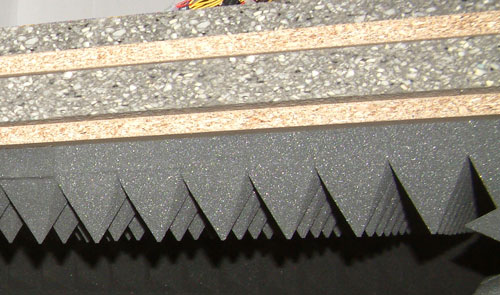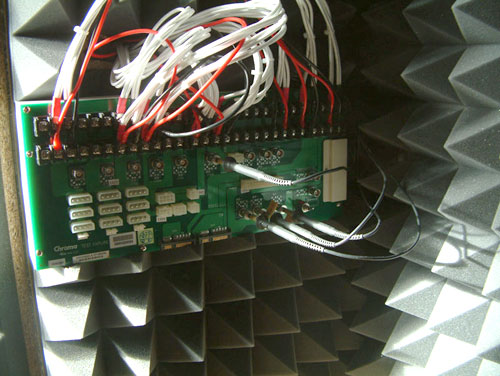Exclusive: Antec Signature 850W
by Christoph Katzer on May 7, 2008 2:00 AM EST- Posted in
- Cases/Cooling/PSUs
Testing with the Chroma ATE Programmable Load

Our test equipment consists of two Chroma programmable DC Loads that enable us to test power supplies with an output of up to 1500W. The biggest advantage of the Chroma DC Loads is simply the high precision it provides. It can measure differences as small as 0.001V and 0.0001A, which will provide us with best-in-class results.
When programming the Chroma with specific amounts of load calculated according to the ATX norm, we are able to load power supplies to an exact percentage. We can now show results at every specific percentage needed. To get the best overview of a power supply, we load each unit with 10%, 20%, 50%, 80%, 100%, and 110% of the specified output. This is easy to calculate for a 1000W power supply: the 10% load is 100W and 110% load is 1100W. Remember that this is the amount of power the PSU delivers; due to inefficiencies, a power supply will actually draw more power from the wall.
Note: If you would like to know more about our testing methodology, equipment, and environment, please read our PSU testing overview.
We have added an additional 10% on the highest load to see how the units perform with overload. This test will be performed in all future reviews. The overload test is performed at room temperature as well as under more stressful conditions; to ensure we are not too cruel to the power supplies, we will keep the ambient temperature at 50°C in the stress test. Experience shows that many units can stand the overload at room temperature but will experience problems with higher temperature and overload together. Only the best-built units will survive this.

The Testing Environment
There is one flaw in testing power supplies with programmable loads while trying to measure the sound pressure levels at the same time. Because the programmable loads get very loud, there is no chance of hearing the power supply on the test stand. In order to make accurate measurements of the noise levels we needed a way to separate the test unit and the programmable loads. Our solution was to build a very thick box around the unit.

We concluded that a five-layer box with a total thickness of 6" (15cm) containing two layers of wood and three layers of special foam would suffice. It is designed as a box within a box. The inner box does not touch any part of the outer box, making it difficult for acoustic noise to pass through in the form of vibration. Each box is isolated on both sides with a layer of heavy foam that is normally used to insulate engines. On the inside we have an additional layer of 4" (10cm) thick pyramidal foam on every side of the box to eliminate the acoustic waves coming from the test object as well as we can.

To ensure a completely closed system we installed the printed circuit board that the connectors of the power supply are attached to inside the anechoic room/box. In other box designs, you would need to put all the cables through the wall. Unfortunately, that would result in the inside of the box not being fully isolated anymore. Our design keeps everything that needs to be connected inside of the box and maintains isolation.










23 Comments
View All Comments
MrOblivious - Friday, May 9, 2008 - link
You aren't going to get me to say that, but I will say he must be working in a different environment with different people than what we since Corsair, Seasonic, Enermax, SilverStone, etc have all asked/sent units of lower output to be reviewed. In fact, we have so many requests stacked up on those units that we can not take them all because we can not provide any kind of realistic time table to turn them around for them.Don't get me wrong I am all for doing them, but what happens when you throw a party and no one shows up? That is what happens when you do low powered units. Anecdotes of people requesting them can do nothing to change that fact that they get read by fewer people as we see from the page hits which does NO ONE any good as we don't provide the compelling content users want nor the coverage the brand is looking for.
So to answer your question, why target higher powered units? Its because that is what people want to read about.
Christoph Katzer - Friday, May 9, 2008 - link
Agreed on that. I had several lower rated units before but after showing such a bad performance one manufacturer even refused to send any more of that kind. I do have several FSP models coming soon with 300, 400 and 600 watts. I will also be reviewing OEM models from Seasonic and FSP.As much as I would like to test really cheap models I am just stuck with the fact that I am not located in the U.S. and there is simply nobody who would send me all that stuff. I am also interested in seeing what these unit can offer like we have seen at jonnyguru a few month ago. It's just testing for fun since there is nobody really interested in the results. They all blow up when loaded with programmable loads which is the only fun we could offer with such a review.
I will anyway try to have more units from the lower and medium range in the future but there will be again a few higher models since I still have several 850-1000W units here...
Bozo Galora - Wednesday, May 7, 2008 - link
Note to all PSU marketing dep'ts:the day when people will buy a psu with a rats nest of cables puking out the back is slowly but surely fading away
the graphs are some of the worst in recent reviews.
that they would send this thing out as an exclusive first look unit for testing on AT (on a chroma no less) is itself a bit scary
of course, as always, we will soon see an update to the review in a week or two that will report "the voltage drop prob has been fixed - was just a bad run of a certain component"
Stele - Friday, May 9, 2008 - link
To an extent I agree with you. Nevertheless, there are pros and cons to modular power supplies. The most obvious con is the fact that modular power supplies introduce one more connection between the PSU's PCB and the connectors at the other end - with all the attendant issues that these have compared to non-modular power supplies, especially increased manufacturing costs and connection resistance, as well as connector reliability issues (a loose connection carrying 200VA is very bad news).Having said that, it is possible to greatly minimise the impact of such effects; the best thing manufacturers could do is to design and employ robust and rugged connectors with large conductor contact areas - plenty of connector manufacturers with plenty of experience in mission-critical and/or industrial-grade applications out there.
However, that means even higher costs. This would be no big deal in a world where money was no object, but in reality, in order to compete at a given price point this may lead to corners being cut where it really matters - the stuff inside the PSU, and the resulting performance, life expectancy and stability. Those that don't cut the corners end up having brickbats thrown at their naturally high prices.
Of course there're PSUs that are modular yet offer good performance without asking for your firstborn, but those aren't the overwhelming majority.
Personally, if I had to choose for a given price range, I'd take better performance/reliability over modular cables anyday.
harbin - Wednesday, May 7, 2008 - link
I've been using the NeoPower series first entered the market. Quiet, solid PSU. Love it to date. Still runs my o/ced Q6600 happily.InternetGeek - Wednesday, May 7, 2008 - link
I think you guys have it backwards about why antec is better known. Antec is better known for their PSU rather than their cases. ThermalTake is better known for their cases rather than their PSUs.In any case, an excellent PSU.
cg0def - Thursday, May 8, 2008 - link
Both Tt and Antec were making cases before they started making PSUs. Only Antec was making cases long before Tt and the Antec cases used to be synonymous with high quality. I'm not sure that is the case anymore since they are terribly overpriced and many of their models still used steel sheets for the construction.Anyway what I was saying is that Antec IS famous for their cases and NOT the PSUs and it is only in recent years that they have started making splendid PSUs and slightly shifted their focus. Oh and Tt actually became famous for their coolers ( CPU mostly ) and then extended their product line. There used to be a day when Tt heatsinks were the best you can get ...
granulated - Wednesday, May 7, 2008 - link
LOL.. Some, if not all, of the high end Antec PSU's are actually made by Seasonics !SilthDraeth - Wednesday, May 7, 2008 - link
LOLGive the man a cookie.
feelingshorter - Wednesday, May 7, 2008 - link
Perhaps thats a matter of opinion, but i heard about antec cases first before hearing about their PSU. A lot of people (including me at one point), did not understand the importance of a good PSU, thinking any PSU will do fine. So unless your a person that does research on it specifically, you won't know just by chance. Whereas their cases...well they have a lot of cool cases and friends amongst each other will send links through instant messaging saying "look at this cool case from Antec" more often than messages saying "look at this extremely stable PSU".